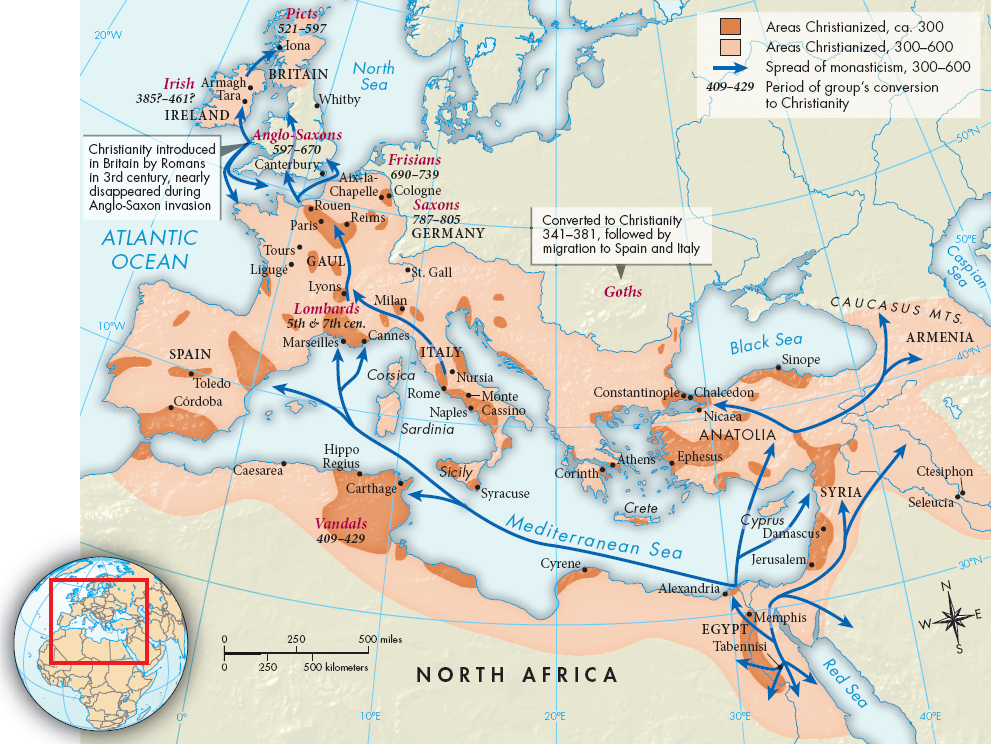The Acceptance of Christianity
Diocletian stepped up persecution of Christians who would not sacrifice to Rome’s traditional deities, portraying them as disloyal to the empire. These persecutions lasted only a few years, however. Increasing numbers of Romans, including members of prominent families, were converting to Christianity, and many who followed traditional Roman religions no longer saw Christianity as un-Roman (see Chapter 6). Constantine reversed Diocletian’s policy and instead ordered toleration of all religions in the Edict of Milan, issued in 313. In addition, he freed the clergy from imperial taxation and endowed the building of Christian churches. In return for his support, Constantine expected the assistance of church officials in maintaining order. Helped in part by its favored position in the empire, Christianity slowly became the leading religion (Map 7.2).

MAP 7.2
The Spread of Christianity to 600Originating in Judaea, the southern part of modern Israel and Jordan, Christianity first spread throughout the Roman world and then beyond it in all directions.
Christians disagreed with one another about many issues, which led to schisms (SKIH-zuhms), denunciations, and sometimes violence. In the fourth and fifth centuries, disputes arose over the nature of Christ. For example, Arianism (AI-ree-uh-nih-zuhm), developed by Arius (ca. 250–336), a priest of Alexandria, held that Jesus was created by the will of God the Father and thus was not co-eternal with him. This doctrine provoked such controversy that Constantine felt it necessary to intercede. In 325, he summoned church leaders to a council in Nicaea (nigh-SEE-uh) in Asia Minor and presided over it personally. The council produced the Nicene (nigh-SEEN) Creed, which defined the position that Christ is “eternally begotten of the Father” and of the same substance as the Father. Arianism was declared a heresy, that is, a belief that contradicted the interpretation the church leaders declared was correct, Interpretations declared correct were termed orthodoxy. These actions did not end Arianism, however. Several later emperors were Arian Christian, and Arian missionaries converted many barbarian tribes.
In 380, the emperor Theodosius (thee-uh-DOH-shee-uhs) made Nicene Christianity the official religion of the empire. Theodosius stripped Roman pagan temples of statues, made the practice of the old Roman state religion a treasonable offense, and persecuted Christians who dissented from orthodox doctrine. Most significant, he allowed the church to establish its own courts and to use its own body of law, called canon law. The church courts, not the Roman government, had jurisdiction over the clergy and ecclesiastical disputes. At the death of Theodosius, the Christian Church was considerably independent of the Roman state. The foundation for later growth in church power had been laid.
Later emperors continued the pattern of active involvement in church affairs. They appointed the highest officials of the church hierarchy, the emperors or their representatives presided at ecumenical councils, and the emperors controlled some of the material resources of the church—land, rents, and dependent peasantry.
Why did the political and economic reforms initiated by Diocletian and Constantine fail to reverse the slow decline of the Roman Empire in the West?
